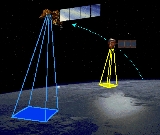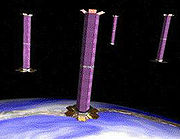
Satellite formation flying
Encyclopedia
Satellite
formation flying is the concept that multiple satellites can work together in a group to accomplish the objective of one larger, usually more expensive, satellite. Coordinating smaller satellites has many benefits over single satellites including simpler designs, faster build times, cheaper replacement creating higher redundancy, unprecedented high resolution, and the ability to view research targets from multiple angles or at multiple times. These qualities make them ideal for astronomy
, communication
s, meteorology
, and environmental
uses.
 Depending on the application, there are three formations possible: trailing, cluster, and constellation
Depending on the application, there are three formations possible: trailing, cluster, and constellation
.
Usually, these formations are made up of numerous small satellites. A micro satellite
weighs under 100kg and a nano satellite
weighs under 10kg. Magnetosheric Constellation, for instance, would be composed of 100 micro satellites.(see http://sec.gsfc.nasa.gov/roadmap_posters_mc.pdf)
This technology has become more viable thanks to the development of autonomous flying. With an on board computer and this algorithm, satellites may autonomously position themselves into a formation. Previously, ground control
would have to adjust each satellite to maintain formations. Now, satellites may arrive at and maintain formations with faster response time and have the ability to change the formation for varied resolution of observations. Also, satellites may be launched from different spacecrafts and rendezvous on a particular path. This advance was made possible by Dave Folta, John Bristow, and Dave Quinn at NASA
’s Goddard Space Flight Center
(GSFC).

Satellite
In the context of spaceflight, a satellite is an object which has been placed into orbit by human endeavour. Such objects are sometimes called artificial satellites to distinguish them from natural satellites such as the Moon....
formation flying is the concept that multiple satellites can work together in a group to accomplish the objective of one larger, usually more expensive, satellite. Coordinating smaller satellites has many benefits over single satellites including simpler designs, faster build times, cheaper replacement creating higher redundancy, unprecedented high resolution, and the ability to view research targets from multiple angles or at multiple times. These qualities make them ideal for astronomy
Astronomy
Astronomy is a natural science that deals with the study of celestial objects and phenomena that originate outside the atmosphere of Earth...
, communication
Communication
Communication is the activity of conveying meaningful information. Communication requires a sender, a message, and an intended recipient, although the receiver need not be present or aware of the sender's intent to communicate at the time of communication; thus communication can occur across vast...
s, meteorology
Meteorology
Meteorology is the interdisciplinary scientific study of the atmosphere. Studies in the field stretch back millennia, though significant progress in meteorology did not occur until the 18th century. The 19th century saw breakthroughs occur after observing networks developed across several countries...
, and environmental
Natural environment
The natural environment encompasses all living and non-living things occurring naturally on Earth or some region thereof. It is an environment that encompasses the interaction of all living species....
uses.
Types of formations

Satellite constellation
A group of artificial satellites working in concert is known as a satellite constellation. Such a constellation can be considered to be a number of satellites with coordinated ground coverage, operating together under shared control, synchronised so that they overlap well in coverage and...
.
- Trailing formations are formed by multiple satellites orbiting on the same path. They are displaced from each other at a specific distance to produce either varied viewing angles of one target or to view a target at different times. Trailing satellites are especially suited for meteorological and environmental applications such as viewing the progress of a fire, cloud formations, and making 3D views of hurricanes. Notable pairs are Landsat 7Landsat 7Landsat 7, launched on April 15, 1999, is the latest satellite of the Landsat program. Landsat 7's primary goal is to refresh the global archive of satellite photos, providing up-to-date and cloud-free images. The Landsat Program is managed and operated by the USGS, and data from Landsat 7 is...
with EO-1 (see http://eo1.gsfc.nasa.gov/), CALIPSOCALIPSOCALIPSO is a joint NASA and CNES environmental satellite, built in the Cannes Mandelieu Space Center, which was launched atop a Delta II rocket on April 28, 2006. Its name stands for Cloud-Aerosol Lidar and Infrared Pathfinder Satellite Observations...
with CloudSatCloudSatCloudSat is a NASA Earth observation satellite, which was launched on a Delta II rocket on 28 April 2006. It uses radar to measure the altitude and properties of clouds, adding to information on the relationship between clouds and climate in order to help resolve questions about global warming...
, and TerraTerra (satellite)Terra is a multi-national NASA scientific research satellite in a sun-synchronous orbit around the Earth. It is the flagship of the Earth Observing System...
with AquaAqua (satellite)Aqua is a multi-national NASA scientific research satellite in orbit around the Earth, studying the precipitation, evaporation, and cycling of water. It is the second major component of the Earth Observing System preceded by Terra and followed by Aura .The name "Aqua" comes from the Latin word...
. - Cluster formations are formed by satellites in a dense (relatively tightly spaced) arrangement. These arrangements are best for high resolution interferometryAstronomical interferometerAn astronomical interferometer is an array of telescopes or mirror segments acting together to probe structures with higher resolution by means of interferometry....
and making maps of Earth. Example: TechSat-21TechSat-21TechSat-21 was a small spacecraft developed by the U.S. Air Force Research Laboratory’s Space Vehicles Directorate to test technology for formation flight of spacecraft which can rapidly change formation based on mission requirements. The project was canceled in 2003 due to numerous cost overruns....
.
Usually, these formations are made up of numerous small satellites. A micro satellite
Miniaturized satellite
Miniaturized satellites or small satellites are artificial satellites of unusually low weights and small sizes, usually under . While all such satellites can be referred to as small satellites, different classifications are used to categorize them based on mass .One reason for miniaturizing...
weighs under 100kg and a nano satellite
Miniaturized satellite
Miniaturized satellites or small satellites are artificial satellites of unusually low weights and small sizes, usually under . While all such satellites can be referred to as small satellites, different classifications are used to categorize them based on mass .One reason for miniaturizing...
weighs under 10kg. Magnetosheric Constellation, for instance, would be composed of 100 micro satellites.(see http://sec.gsfc.nasa.gov/roadmap_posters_mc.pdf)
This technology has become more viable thanks to the development of autonomous flying. With an on board computer and this algorithm, satellites may autonomously position themselves into a formation. Previously, ground control
Mission Control Center
A mission control center is an entity that manages aerospace vehicle flights, usually from the point of lift-off until the landing or the end of the mission. A staff of flight controllers and other support personnel monitor all aspects of the mission using telemetry, and send commands to the...
would have to adjust each satellite to maintain formations. Now, satellites may arrive at and maintain formations with faster response time and have the ability to change the formation for varied resolution of observations. Also, satellites may be launched from different spacecrafts and rendezvous on a particular path. This advance was made possible by Dave Folta, John Bristow, and Dave Quinn at NASA
NASA
The National Aeronautics and Space Administration is the agency of the United States government that is responsible for the nation's civilian space program and for aeronautics and aerospace research...
’s Goddard Space Flight Center
Goddard Space Flight Center
The Goddard Space Flight Center is a major NASA space research laboratory established on May 1, 1959 as NASA's first space flight center. GSFC employs approximately 10,000 civil servants and contractors, and is located approximately northeast of Washington, D.C. in Greenbelt, Maryland, USA. GSFC,...
(GSFC).

See also
- Satellite constellationSatellite constellationA group of artificial satellites working in concert is known as a satellite constellation. Such a constellation can be considered to be a number of satellites with coordinated ground coverage, operating together under shared control, synchronised so that they overlap well in coverage and...
- Fractionated spacecraftFractionated SpacecraftA fractionated spacecraft is a satellite architecture where the functional capabilities of a conventional monolithic spacecraft are distributed across multiple modules which interact through wireless links...
- Magnetospheric Multiscale MissionMagnetospheric Multiscale MissionThe Magnetospheric Multiscale Mission is a NASA unmanned space mission, to study the Earth's magnetosphere using four identical spacecraft flying in a tetrahedral formation...
External links
- BNSC "Formation Flying"
- Cranfield School of Engineering - Space Research Center
- Asia Times Sep 2, 2009 Satellites flying in formation over Asia

